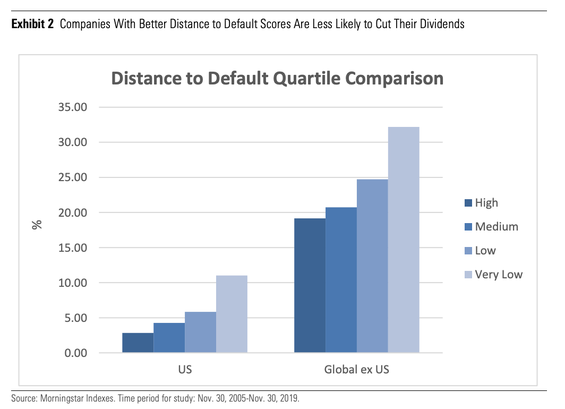Vodafone (VOD) had raised its dividend each year since 1998 when it cut its payment to shareholders by 40% in 2019. Bank of America (BAC) had a track record of dividend payments extending back to the 1980s before cutting in 2008. ConocoPhillips (COP), Deutsche Bank (DB), and General Electric (GE) were all dividend champions—until they weren’t.
Dividend-paying stocks are much loved for their income stream, but they can be risky. When investors look for the market’s highest yielders or rely on backward-looking statistics, they can find themselves holding the shares of troubled companies that go on to cut or suspend their dividends and suffer painful share-price declines.
Dividend payers tend to serve investors best when they’re screened for factors that signal trouble ahead—such as financial health. Among the screens that Morningstar employs in its range of dividend indexes is Distance to Default, which gauges a company’s capacity to sustain a payout to shareholders. Our new research, “Health Screening for Dividend Payers,” shows that the Distance to Default measure helps predict dividend sustainability.
The Link Between Financial Health and Dividends
If a company has a shaky balance sheet, struggles with solvency, or experiences share-price volatility due to questions regarding its long-term viability, its future dividend payments are in jeopardy. After all, dividends are not guaranteed. Unlike debtholders, owners of a company’s regular equity shares have no claims on the company’s assets.
Distance to Default is a quantitative measure of a company’s financial health. As the name implies, it gauges the likelihood that a company’s assets will fall below the value of its debt. Not only does Distance to Default look at balance sheet strength, but it also incorporates market-based information. Inputs such as a company’s equity value and the volatility of its equity are critical because share prices are often leading indicators of financial distress.
As shown on the chart below, companies with better Distance to Default scores (expressed on the Y-axis) are less likely to experience dividend cuts (the odds of this are charted on the X-axis). 
But the study accounts for different dividend practices across regions. Globally, companies with better Distance to Default scores cut their dividends less frequently during the 15-year period covered in the study (2005 to 2019).
Incorporating Financial Health Into Dividend Indexing
Thanks to Distance to Default, Morningstar’s dividend indexes have avoided many dividend payers that went on to experience payout cuts and share-price declines. The list of companies spans sector, geography, and time period. It includes names like Kraft Heinz (KHC), Anheuser-Busch InBev (BUD), Telstra (TTRAF), and Singapore’s StarHub (SRHBF).
The study demonstrates the peril of selecting dividend-paying stocks based on yield or dividend history. Income is important. But by screening out companies at risk of financial distress, Morningstar’s dividend indexes don’t jeopardize long-term total return.
Dan Lefkovitz is a strategist for Morningstar's Indexes product group.


